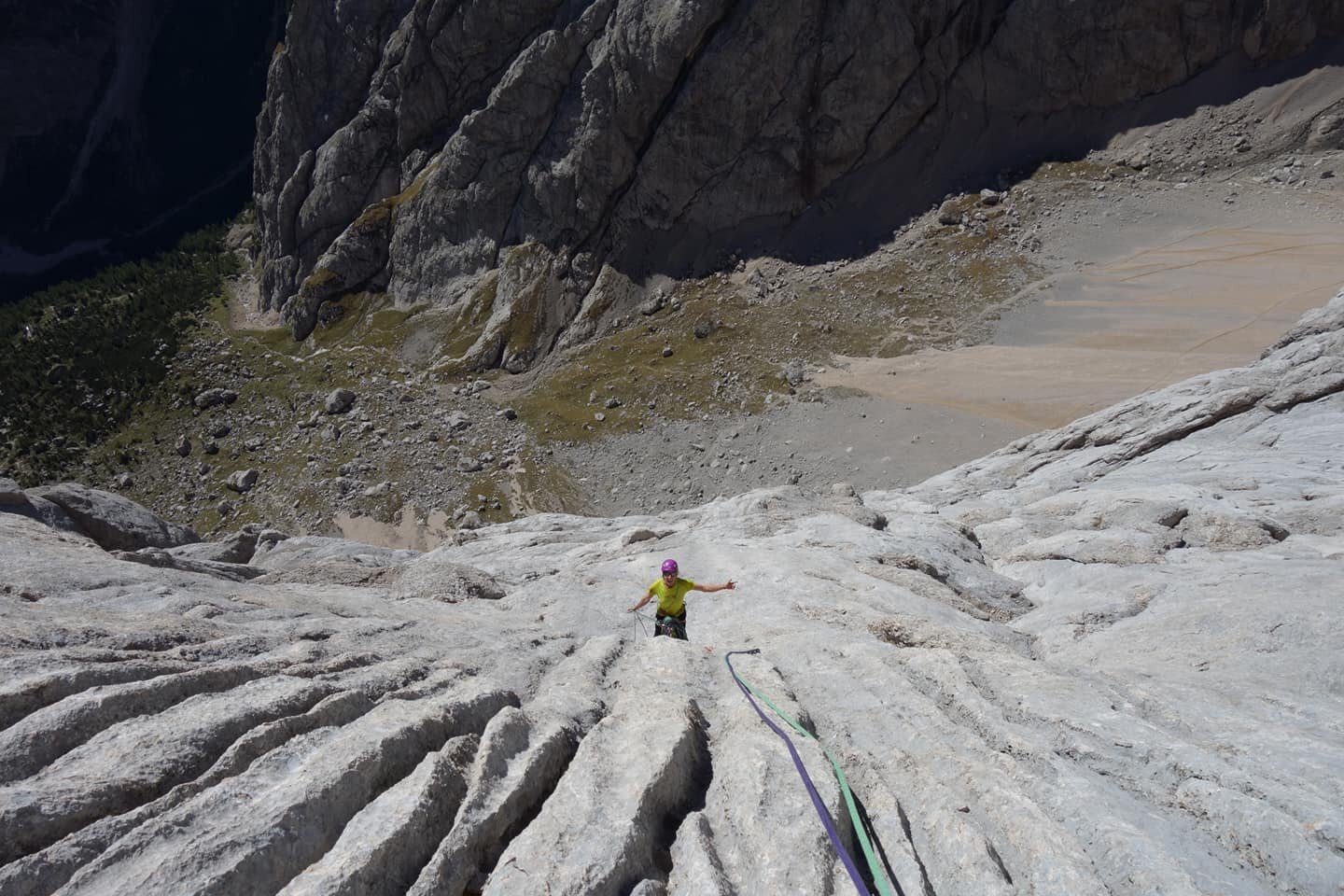The Vinatzer - Messner route on the south face of the Marmolada.
By Katie Keeley
The Marmolada, known as the queen of the Dolomites, is an impressive mountain that draws the eye from the peak of many neighbouring summits, and she captured my imagination from the very first time I saw her. I spent 2 winters ski touring down her flanks on the north face and ice climbing in the gorges that sit at the base, hidden in her shadow. But the famous south face, that vertical kilometre of perfect compact limestone, kept coming back to me. Intriguing, alluring and yet overwhelmingly intimidating.
Questing into the sea of rock
Although I had stood on the summit several times by then, I had never fully seen the south face. I had read about it, heard stories and seen photographs, but never looked upon it with my own eyes. Near the end of the winter season in 2018 I did a ski tour up the Val Ombretta and finally gazed upon the great south face. Soaring 1000m above the valley floor, it seemed like the most beautiful and formidable wall of rock I had ever seen. I made a promise to myself right there that I would come back and climb it.
In late September 2018 I found myself back there with my Austrian friend David, this time with a bag full of climbing gear and filled with that cocktail of psyche and trepidation that I always get when I am about to do something big!
We parked at Malga Ciapela in the early evening and hiked for an hour or so up the valley to the Refugio Malga O. Falier. As it was late in the season the Refugio was shut and we were sleeping the night in the winter room. We arrived just as darkness descended and the first stars came out to light up the sky. Unsurprisingly we were the only ones staying there on the 29th September!
We had decided on Vinatzer Messner as it seemed like a good introductory route to the face. At 30 pitches, covering 1100m of rock it would be long and challenging, but it felt manageable and the rock quality was said to be excellent. It is graded VI+ which is very roughly E2. I felt like although the climbing was never overly difficult it was consistent and committing and rather run out at times! Due to the ever shortening days (given that it was almost October) we decided to split the route in 2 and bivy at the half way ledge. Partly so we could enjoy the climb without rushing and partly because it seemed like an amazing adventure to sleep on a ledge 600m up a giant rock face!
So 5.30 am saw us heading out towards the face, still shrouded in early morning darkness, just the vast silhouette of the Queen visible in the pre dawn light. We passed a cave a few hundred meters up from the Refugio which would also make an excellent bivy spot if you didn't want to stay at the hut.
David lead the first pitch off the ground which I have to say was a very polished and strenuous chimney; a rude introduction to our cold fingers and sleepy heads. We later read that there is an alternative pitch that now starts around to the left of the traditional start and is much more pleasant.
Wild Positions!!
However after the slippery start the climbing improved and just kept on getting better. It is varied and interesting all the way with steep crack systems, and some awkward chimneys made all the more tricky with our big packs. On the crux pitch I ended up leaving my bag hanging on a piece of gear and hauling it up after David.
As we were both new to this 2 day route idea we had brought way too much stuff with us. A big sleeping bag each, sleeping mats, food and a full stove! However it was almost worth it in the end to have such a comfortable and luxurious night up on the ledge! I think most people rough it out, sitting in a down jacket and eating biscuits but we ate and slept like Kings up there :D
The second half of the Vinatzer line continues on increasingly good rock, giving you a little taste of that incredible compact grey slab you experience upon reaching the Messner route. The final 4 pitches follow a continuous groove system for about 150m with some fantastic climbing all the way up to the ledge.
We reached the ledge with a few hours of daylight left giving us time to sit and enjoy the views. It is a huge rock band that splits the face in two, with plenty of options for bivy sites. We found a small drip of water over on the left of the ledge( facing in) that we managed to (slowly) fill our bottles up from and a few icicles which we melted in our stoves to cook and make tea. Snuggled up in my sleeping bag, watching the surrounding peaks flush a fiery orange, before fading to pink as the sun dropped behind the horizon, I felt completely content. I was here. There was nothing else and nowhere else.
Waking up to sunrise on the halfway bivi ledge
Waking up on the wall was a very special feeling. We sat side by side in silence watching the sun slowly rise, feeling the first rays of light on our faces, just smiling.
A couple of coffees later and I found myself pulling steeply up over a small overhang which got us off the ledge and into the sea of endless grey slab that rose in waves above us. The first few pitches are straight forward but the route finding can be tricky given that there are no real distinctive features. You feel like a tiny dot floating in an ocean of grey rock that stretches on forever. It seems like you could climb anywhere, everywhere. It is also some of the best quality rock I have ever climbed in my life.
Deep, smooth water worn runnels give some incredible features and the exposure is absolute. Looking down you can see the valley floor hundreds of meters below you. The idea that Messner soloed this in 1969 makes my stomach churn.
We came to the first crux around pitch 5 which for me turned out to be the hardest and most memorable pitch of the route. You have to traverse left off the belay and then make some some bold, technical moves on small pockets and water grooves to reach some tat, about 20 m overhead. There was no way of protecting this apart from possibly if you had tri cams. I didn't have tri cams. I hovered there for a good 20 minutes, climbing up and down up and down, hesitating to commit, knowing that if I fell I would certainly hit the ledge and have broken ankles at best.
Incredible water runnels
Finally, after some deep breathing I moved out of the crack and committed to the slab. I felt fluid, smooth and strong as I pulled through the small finger pockets and smeared my feet on tenuous edges. It was over quickly and I had made it.
The climbing eases off again from here giving proper 'plasir climbing' up solid rock until you reach the final crux at the top of a narrow gully. This is a steep, but positive and well protected crack full of pitons, making it feel much less intense than the run out slab below. From here it is a fairly easy yomp up the shoulder to stand on the summit of Punta Rocca!
If you climb in high season you can take the cable car down, making it a very civilised descent. However it had been shut for a couple of weeks by the time we got there so we had a long, arduous hike down the glacier, slithering over the ice in approach shoes, nut key at the ready for a self arrest! Thankfully we didn't have to test this and find out if it would actually work..
Feeling on top of the world!
Doing this route was an incredible experience and one of the highlights of my climbing to date. Being able to write about it now and reflect on the memories and photos of those days has made me smile and inspired me to start planning the next adventures! I hope reading this has motivated some of you too and maybe plants the seed for a project at the next Women's Alpine Club meet in the Dolomites, be it this year or next year!





